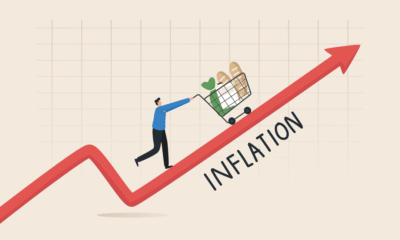Finance
The Rise of Central Bank Digital Currency: What It Means for the Future of the U.S. Dollar

Introduction to Central Bank Digital Currency (CBDC)
Central Bank Digital Currency (CBDC) represents a new frontier in the realm of currencies, fundamentally distinct from both traditional fiat currencies and decentralized cryptocurrencies. CBDCs are government-issued digital currencies, backed by a nation’s central bank, and designed to serve as a legal tender. Unlike traditional currencies that exist primarily in physical form, CBDCs exist solely in digital format, leveraging technology to facilitate transactions in a more efficient manner.
One of the primary differences between CBDCs and cryptocurrencies is the regulatory framework governing each. While cryptocurrencies operate on decentralized networks, often beyond the reach of traditional financial institutions, CBDCs are firmly embedded within the structure of a country’s monetary system. This alignment allows central banks to maintain oversight, ensuring the stability and integrity of the financial system while also providing a reliable medium of exchange for citizens.
The motivation behind the exploration and implementation of CBDCs is multifaceted. Many countries are driven by the necessity to increase the efficiency of their payment systems. Traditional methods of payment can be slow and costly, involving numerous intermediaries; CBDCs promise to streamline this process. Additionally, enhancing financial inclusion is a significant objective. By providing a digital alternative to cash, especially in regions where banking infrastructure is limited, CBDCs can facilitate access to financial services for the unbanked population.
Moreover, central banks are increasingly recognizing the potential of CBDCs to improve the efficacy of monetary policy. By allowing immediate implementation of monetary measures, such as interest rate changes or stimulus payments, CBDCs offer a more responsive tool for economic management. As countries around the world begin to explore these digital currencies, it becomes imperative to understand their implications for the future of the U.S. dollar and the global economy at large.
The U.S. Dollar: A Brief History and Its Current Role
The U.S. dollar has a rich history that dates back to its creation in 1792, when it was established as the standard unit of currency for the United States. Over the centuries, this currency has evolved and adapted to changing economic conditions, positioning itself as the world’s primary reserve currency. Following World War II, the U.S. dollar became increasingly dominant, solidified by the Bretton Woods Agreement in 1944, which established it as the linchpin of the global monetary system. This led to the dollar being pegged to gold and allied currencies pegged to the dollar itself, which fostered unprecedented economic stability and recovery in the post-war period.
Today, the U.S. dollar maintains its status as the leading global reserve currency, a position that influences international trade and finance. Approximately 60% of the world’s reserves are held in dollars, providing the United States with significant leverage in global economic affairs. This dominance allows for lower transaction costs and enhances the country’s capacity to borrow, as investors perceive U.S. Treasury securities as safe-haven assets. As a result, the dollar’s stability not only impacts U.S. monetary policy but also dictates international financial systems and the dynamics of global trade.
The implications of the dollar’s dominance extend to various financial markets, where it is involved in approximately 88% of all currency trades. Moreover, the dollar is often the preferred currency for international transactions, facilitating trade for commodities such as oil, gold, and agricultural products. This widespread acceptance underpins the dollar’s value and has fortified its role as the benchmark for evaluating other currencies. Consequently, any shifts in this dynamic could introduce uncertainties in global economic relations, marking the importance of understanding the historical context and current influence of the U.S. dollar in the complex international landscape.
The Current State of CBDC Developments Globally
As of 2023, central banks worldwide are exploring the implementation of Central Bank Digital Currencies (CBDCs) as a response to the evolving financial landscape and the growing influence of cryptocurrencies. The People’s Bank of China (PBoC) continues to lead the way with its digital yuan, which has entered various pilot programs across major cities, facilitating cashless transactions and gradually increasing its adoption among consumers. This initiative reflects China’s aim to enhance payment efficiency and secure its position in the global financial system.
Similarly, European Central Bank (ECB) is working on the digital euro, emphasizing a digital payment system that complements, rather than replaces, traditional currencies. The ECB has conducted public consultations and is currently in the investigative phase, focusing on issues such as privacy, security, and the impact on the banking sector. Such initiatives illustrate a growing trend among central banks to create CBDCs that promote financial inclusion while addressing potential safety concerns associated with private digital currencies.
In the United States, the Federal Reserve has been studying the implications of a digital dollar extensively, publishing discussion papers outlining the potential benefits and risks. Key concerns include the impact on the current banking infrastructure and monetary policy efficacy. The trajectory of CBDC development in the U.S. remains cautious as the authorities evaluate the best way to integrate such a system with the existing financial framework.
Other nations, including Sweden with its e-krona and the Bahamas with the Sand Dollar, are also pushing forward with their CBDC initiatives. These projects highlight various governance structures, technological choices, and policy objectives. Despite the progress, challenges such as cybersecurity threats, regulatory frameworks, and public acceptance remain integral to the successful adoption of CBDCs globally. As countries navigate these complexities, the diversity in approaches underscores the uniqueness of each nation’s economic environment and regulatory context in this emerging financial realm.
Potential Impacts of a Digital Dollar on Global Markets
The introduction of a central bank digital currency (CBDC), specifically a digital dollar, is poised to have significant impacts on global markets. As the United States contemplates this innovation, it is essential to analyze how it could influence foreign exchange rates, trade balances, and the overall attractiveness of U.S. assets. A digital dollar could potentially reshape international financial dynamics by altering perceptions of the U.S. dollar’s stability and its role as a global reserve currency.
One of the immediate consequences of a digital dollar may be its effect on foreign exchange rates. As digital currencies become integrated into the global financial system, the demand for traditional fiat currencies, including the U.S. dollar, may fluctuate. This shift could lead to increased volatility in currency markets, as investors reassess their strategies in response to the enhanced functionality and accessibility offered by a digital dollar. Moreover, if other nations follow suit in launching their own digital currencies, it could further intensify competition among currencies, potentially diminishing the dollar’s dominance.
In terms of trade balances, the adoption of a digital dollar may facilitate easier and more efficient cross-border transactions, thereby impacting trade volume and relationships. If businesses can transact more swiftly using a digital dollar, it could enhance the competitiveness of U.S. exports, potentially improving trade balances. However, this increased efficiency could also expose U.S. firms to heightened competition from foreign digital currencies that offer similar benefits.
Ultimately, the attractiveness of U.S. assets may also be influenced by the advent of a digital dollar. As investors globally evaluate their asset portfolios, the potential for reduced transaction costs and enhanced liquidity could lead to a reallocation of investments across borders. While a digital dollar promises numerous benefits, it is crucial to approach these potential impacts with a measure of caution to ensure the stability of the global financial system is maintained.
Effects on Traditional Banking Systems
The advent of Central Bank Digital Currency (CBDC), particularly in the form of a digital dollar, has prompted significant discussions regarding its impact on traditional banking systems. One of the primary implications is the potential change in the role of banks as intermediaries. With a digital dollar facilitating direct transactions between consumers and the central bank, the function of commercial banks as intermediaries may become diminished. This shift could lead to a more streamlined payment system, where individuals can hold accounts directly with the Federal Reserve, bypassing traditional banks altogether.
Moreover, the relationship between banks and their customers will likely evolve. Currently, banks provide various services, including checking accounts, savings accounts, and loans, which depend on depositors’ funds. However, with the introduction of a CBDC, customers may feel less incentive to maintain funds in traditional bank accounts, preferring instead to utilize digital wallets connected directly to the central bank. This change could potentially lead to a reduction in deposits for banks, thereby affecting their ability to lend and generate interest income.
Another significant concern is the potential impact on liquidity and bank profitability. As consumers migrate toward holding digital dollars, traditional banks may face liquidity challenges, affecting their operational sustainability. Reduced deposits could translate into less available capital for lending, which is crucial for generating revenue and maintaining healthy profit margins. Furthermore, banks might also need to adapt their business models and services to attract and retain clients in an increasingly digital financial landscape.
The transformation brought about by a digital dollar promises to alter the interplay between central banks and traditional banking institutions significantly, contributing to a more dynamic and potentially competitive financial ecosystem.
Digital Dollar and Financial Inclusion
Central Bank Digital Currency (CBDC), particularly the proposed digital dollar, has the potential to significantly enhance financial inclusion across the United States. For a considerable portion of the population, particularly the unbanked and underbanked, accessing traditional banking services can be challenging due to various barriers including geographic, economic, or social constraints. A digital dollar could streamline access to banking services for these underserved groups, effectively leveling the economic playing field.
The implementation of a digital dollar can bridge gaps in the financial system. It could provide an efficient, cost-effective means for individuals to conduct transactions without the need for a traditional bank account. This initiative could empower those who currently rely on cash transactions, offering them a secure digital alternative. As digital currencies continue to evolve, the ease of access can lead to increased participation in the economy, fostering greater financial independence and stability among marginalized communities.
However, the transition to a digital dollar is not without its challenges. Privacy concerns, cybersecurity risks, and the potential for digital divide issues must be approached carefully. If a digital currency is not designed with inclusivity in mind, there might be a risk of exacerbating existing inequalities. Equitable access to the necessary technology, including internet connectivity and digital literacy, will be crucial to ensure that the benefits of a CBDC extend to all segments of the population.
In assessing the benefits of a digital dollar, it also becomes essential to evaluate policies that promote digital literacy and the necessary infrastructure to support a successful transition. Stakeholders must collaborate to devise strategies that mitigate risks while maximizing the potential advantages of a CBDC, ultimately paving the way for higher economic equality and enhanced financial inclusion for all individuals.
Privacy and Security Concerns with CBDCs
The advent of Central Bank Digital Currencies (CBDCs) has prompted important discussions surrounding privacy and security, particularly in the context of implementing a digital dollar. As financial transactions increasingly migrate to electronic platforms, concerns about surveillance and the protection of personal data have become paramount. The introduction of CBDCs could potentially lead to enhanced monitoring of consumer transactions, raising questions about data privacy. Instead of fostering anonymity, a digital dollar might empower central banks and governments to track citizens’ financial activities, which could lead to increased scrutiny and, in some instances, misuse of data.
Moreover, security threats related to CBDCs cannot be overlooked. Cybersecurity risks pose a substantial concern as central banks would need to implement robust systems to safeguard digital currencies from hacking and fraud. Data breaches and technical vulnerabilities could have dire implications, undermining public trust in the financial system. Ensuring the integrity and security of transactions will be critical to the successful adoption of CBDCs. This necessitates the establishment of comprehensive infrastructure designed to mitigate risks and protect the interests of consumers, as any lapse could erode confidence in this innovative financial solution.
Balancing the efficiency offered by CBDCs and the need for consumer protection presents a significant challenge. While a digital dollar can streamline transactions and enhance financial inclusion, it is essential to ensure that consumer rights are upheld, and privacy is guaranteed. Robust regulatory frameworks must be in place to address these concerns while fostering an environment where digital currencies can thrive. As central banks explore the potential of CBDCs, addressing issues related to privacy and security will be critical in shaping public perception and acceptance of this new form of money.
The Future of Monetary Policy with CBDCs
The emergence of Central Bank Digital Currencies (CBDCs), particularly a digital version of the U.S. dollar, stands to revolutionize traditional monetary policy frameworks employed by the Federal Reserve. As digital currencies gain traction, their unique features promise to enhance the efficacy of existing monetary policy tools. Specifically, CBDCs could facilitate a deeper integration of monetary mechanisms within the economy, enabling more direct and timely responses to economic fluctuations.
One significant advantage of CBDCs is their potential to streamline the implementation of quantitative easing (QE). In scenarios where the Federal Reserve seeks to stimulate the economy, a digital dollar could allow for direct transfers to consumers and businesses, bypassing intermediary financial institutions. This direct method of distribution may lead to increased velocity of money, ensuring that monetary stimulus reaches those who need it most in real-time, thus promoting economic stability.
Moreover, the deployment of CBDCs could yield greater transparency in monetary transactions. This increased visibility may empower central banks to make more informed decisions based on real-time data on spending behaviors and economic activity. Enhanced data analytics could ultimately lead to the development of more responsive monetary policies tailored to current economic conditions.
Furthermore, CBDCs could help mitigate the risks associated with traditional banking systems, particularly during periods of heightened economic uncertainty. By offering a secure digital form of currency, the Federal Reserve might reduce the likelihood of bank runs as individuals could store their assets directly with the central bank, thereby assuring more stability in the financial system.
As we consider the future of monetary policy in the context of CBDCs, the possibility of adaptive and proactive interventions presents an exciting frontier for central banks, marking a significant shift in how monetary authority can better serve economic stability.
Conclusion: The Path Forward for a Digital Dollar and Global Finance
The emergence of Central Bank Digital Currencies (CBDCs) marks a significant development in the global financial landscape, particularly concerning the U.S. dollar’s position as the world’s dominant reserve currency. Throughout this discussion, we have explored how CBDCs can potentially streamline payment systems, enhance financial inclusion, and improve traceability of transactions. However, the introduction of a digital dollar prompts questions about monetary policy, regulatory frameworks, and the impacts on commercial banks.
The uncertain future of CBDCs highlights the need for a careful approach to their implementation. Central banks must weigh the benefits of issuing a digital currency against potential risks, such as cybersecurity threats, consumer privacy issues, and the potential disruption of existing financial institutions. The U.S. dollar, which has historically provided stability and confidence in international trade, now faces challenges as other nations explore their CBDCs. This could lead to shifts in how global finance operates, impacting everything from exchange rates to international investment flows.
Stakeholders across the financial ecosystem, including governments, banks, and consumers, must engage in informed discussions regarding the implications of this seismic shift. As research continues to evolve, understanding the technical, economic, and social ramifications of a digital dollar will be essential for policymakers aiming to maintain the dollar’s status while accommodating new financial technologies. The balance between innovation and stability will be critical in ensuring that the introduction of a digital currency serves the interests of the wider economy and fosters trust among its users.
In conclusion, continued dialogue and investigation into CBDCs are imperative as we navigate this complex transition. The rise of a digital dollar presents both opportunities and challenges that will shape the future of global finance in profound ways. It is essential that all parties remain proactive in addressing these changes to ensure a stable financial future.

Investing
Global Investor Outflows from U.S. Stocks & Dollar

In a shift that is sending ripples across financial markets, institutional investors around the world are pulling back from U.S. equities and reducing exposure to the U.S. dollar, signaling a significant change in sentiment toward American assets. According to the latest Bank of America Global Fund Manager Survey, global investors are now the most underweight on U.S. stocks in more than two decades, with the dollar facing similar skepticism as a long-term safe-haven asset. This transition is being fueled by multiple converging factors, including geopolitical instability, growing U.S. fiscal deficits, trade tensions, and an increasingly favorable investment climate in Europe and select emerging markets. For investors, economists, and policymakers alike, this trend represents a rebalancing of global capital flows that could reshape market dynamics in the months ahead.
Investor Sentiment Toward U.S. Markets Hits Multi-Year Lows
The Bank of America survey, considered a key barometer of global institutional sentiment, reveals that fund managers have turned heavily underweight on U.S. stocks and the dollar, preferring instead to rotate their portfolios into European and Asian equities. The survey showed that 36% of participants are now net underweight U.S. equities—the highest level since 2003. At the same time, positioning on the dollar turned net negative for the first time in over five years, with investors citing mounting fiscal concerns, valuation extremes, and weakening macroeconomic indicators.
The U.S. equity market, especially the tech-heavy NASDAQ, has experienced an extraordinary bull run over the last several years. But now, investors are questioning the sustainability of elevated valuations, particularly as economic growth slows, earnings forecasts are revised downward, and inflation remains persistently above target. Many portfolio managers believe the best returns may no longer be found in U.S. assets alone.
Rising U.S. Debt and Fiscal Deficits Raise Red Flags
A key driver of investor caution is the ballooning U.S. fiscal deficit. The Congressional Budget Office (CBO) projects that the U.S. federal deficit will reach over $1.8 trillion this year, driven by increased government spending, rising interest costs, and lower-than-expected tax revenues. The national debt is now projected to exceed 125% of GDP by 2030, raising serious questions about long-term fiscal sustainability.
Investors fear that soaring U.S. debt levels could lead to a loss of confidence in Treasury securities, pushing yields higher and triggering volatility in global credit markets. This concern is magnified by the growing political polarization in Washington, which has led to repeated debt ceiling standoffs and policy gridlock. As a result, some asset managers are choosing to diversify their bond portfolios with sovereign debt from countries like Germany, Canada, and Australia—nations viewed as having stronger fiscal discipline.
Geopolitical Tensions Erode Dollar Safe-Haven Appeal
The traditional role of the U.S. dollar as a global safe-haven currency is also being called into question. With the U.S. now embroiled in rising geopolitical conflicts, including its military engagement in the Middle East and an escalating trade war with China, the perception of the dollar as a “neutral” or stable currency is beginning to fade. Several countries, particularly in the Global South, have voiced frustration over the dominance of the dollar in international trade, and some have even accelerated efforts to settle trade in alternative currencies such as the euro, yuan, or local currency blocs.
In response, central banks in emerging markets are reducing their U.S. dollar reserves and increasing holdings in gold and non-dollar currencies. This trend, while gradual, is gaining momentum and contributing to the dollar’s underperformance against a basket of global currencies. The U.S. dollar index (DXY) has declined by nearly 6% year-to-date, reflecting both diminished investor confidence and a broader reconfiguration of reserve management strategies.
Attractive Valuations Abroad Drive Capital Outflows
While risks in the U.S. are mounting, attractive investment opportunities abroad are also contributing to the outflow of capital from American markets. European equities, particularly in sectors like green energy, luxury goods, and financial services, are seeing renewed interest thanks to relatively low valuations and improving macroeconomic stability. The recent ECB rate cuts and Eurobond discussions have added to optimism about the region’s fiscal and financial integration.
In Asia, countries like India, Indonesia, and Vietnam are emerging as new hotspots for foreign direct investment and equity inflows. These economies offer robust growth prospects, younger demographics, and increasingly tech-driven industries. Additionally, Japan’s bond market is seeing increased institutional buying, as long-term yields rise in response to the Bank of Japan’s policy changes.
This global diversification strategy is not just about seeking higher returns—it’s also about managing risk. Investors are increasingly looking to balance their portfolios geographically, reducing dependence on any single region and hedging against macroeconomic shocks that may be specific to the U.S.
Currency Hedging and Diversification as Defensive Strategies
In response to the dollar’s volatility, many fund managers are now engaging in currency hedging strategies to protect their portfolios. Currency ETFs, options, and forward contracts are being used to minimize the downside risk of a weakening dollar. At the same time, global investment funds are ramping up their exposure to non-dollar-denominated assets, including eurozone corporate bonds, emerging market debt, and local-currency sovereign issues.
Moreover, ESG and green bond markets in Europe and Asia are attracting capital due to their alignment with global sustainability goals. These instruments not only offer diversification but also align with broader institutional mandates on responsible investing.
Implications for U.S. Markets and Monetary Policy
The capital flight from U.S. assets could have significant implications for American markets. A persistent decline in foreign demand for U.S. Treasuries may force the Federal Reserve to intervene more frequently in the bond market to maintain liquidity and control yields. At the same time, a weaker dollar could contribute to imported inflation, complicating the Fed’s efforts to bring core inflation back within its target range.
On the equities side, if investor outflows persist, U.S. companies may face higher capital costs and declining valuations, particularly in sectors that rely heavily on foreign investment or exports. Domestic pension funds and institutional investors may need to fill the gap left by global investors, which could further alter asset allocation strategies and influence corporate financing decisions.
A New Era of Global Capital Rotation
The growing shift away from U.S. stocks and the dollar signals the beginning of a new era in global investing, one defined by diversification, geopolitical hedging, and currency rebalancing. While the U.S. remains a central player in global finance, the days of unquestioned dominance are beginning to fade, as investors embrace a more nuanced and distributed view of risk and opportunity.
For market participants, staying agile in this environment means tracking global fund flows, monitoring geopolitical developments, and reassessing the traditional U.S.-centric portfolio model. As capital continues to flow into European and Asian markets, the future of global finance is being rewritten—and those who adapt early may find themselves ahead of the curve.
Finance and Economy
France Pushes Eurozone Toward Joint Eurobond Issuance

In a bold move that could redefine the financial architecture of the European Union, France has renewed its push for the issuance of joint eurozone debt instruments – commonly referred to as Eurobonds – as a way to strengthen the euro on the global stage. As the EU prepares for its upcoming summit on June 26-27, the proposal is once again stirring heated debate among member nations. French officials argue that a shared debt mechanism is essential not only for financial resilience but also for elevating the euro’s standing as a credible alternative to the U.S. dollar. While the idea garners support from key institutions like the IMF and the ECB, resistance from fiscally conservative member states continues to block consensus. This article explores the implications of France’s proposal, the potential benefits and challenges of Eurobond issuance, and the evolving role of the euro in a multipolar financial world.
France’s Strategic Case for Eurobonds
French President Emmanuel Macron and Finance Minister Bruno Le Maire have long been advocates for deeper EU financial integration. According to them, Eurobonds would represent a tangible step toward fiscal solidarity and monetary cohesion, allowing member nations to borrow at collectively favorable rates while demonstrating political unity. The latest push comes at a time when the European economy is facing several headwinds: slowing growth, fragmented recovery across member states, and heightened global financial volatility triggered by geopolitical conflicts and energy insecurity. Macron has reiterated that a common debt tool is essential for financing major EU-wide projects such as green energy transition, digital infrastructure, and military defense.
From a strategic standpoint, France views Eurobonds as more than just a financial mechanism – they are a symbol of EU credibility and resilience. By pooling risk and aligning borrowing capacity, the eurozone could present a united front in capital markets, reducing the vulnerability of weaker economies and improving the euro’s attractiveness to foreign investors.
The Euro’s Current Global Standing and Its Challenges
Despite being the world’s second most-used currency, the euro still lags far behind the U.S. dollar in terms of global reserve share, trade settlement, and safe-haven preference. Analysts point out that one of the primary reasons for this is the fragmented nature of the eurozone bond market. Each country issues its own sovereign debt, leading to a lack of a single, risk-free eurozone bond benchmark – unlike U.S. Treasuries, which offer deep liquidity and low risk.
France’s proposal seeks to address this imbalance. A unified Eurobond market could create a highly liquid, stable, and scalable financial product that would attract central banks, pension funds, and sovereign wealth investors. Over time, this could shift more global reserves into euros, boosting the currency’s influence in global trade and finance.
Institutional Support: IMF, ECB, and Market Participants
Key international organizations have thrown their weight behind the idea. The International Monetary Fund (IMF) has suggested that Eurobonds could enhance the EU’s fiscal capacity and crisis response agility. Meanwhile, European Central Bank (ECB) officials, including President Christine Lagarde, have hinted that deeper fiscal integration is necessary for the euro to realize its full potential.
Financial market participants have also shown interest. Asset managers argue that Eurobonds could become a cornerstone of fixed-income portfolios, particularly for investors looking to diversify away from dollar-denominated assets. Some analysts compare the opportunity to the creation of the U.S. Treasury market in the post-war era, which laid the groundwork for the dollar’s global dominance.
Opposition from the Frugal Four and Risk-Sharing Concerns
Despite France’s enthusiasm and institutional support, significant opposition persists from fiscally conservative EU nations, notably Germany, Austria, the Netherlands, and Finland—often dubbed the “Frugal Four.” These countries argue that shared debt would penalize responsible fiscal behavior and open the door to moral hazard, where weaker economies might overborrow under the protection of joint guarantees.
German officials have also cited constitutional constraints and public opposition to any perceived “debt mutualization.” Instead, they advocate for reforms at the national level, more stringent budget controls, and the use of existing mechanisms like the European Stability Mechanism (ESM) for crisis funding.
This divide continues to stall formal negotiations. At the heart of the debate is the question of trust and fiscal governance, as many northern states remain skeptical about the long-term commitment of their southern counterparts to austerity and budget discipline.
Implications for Financial Markets and Investors
If approved, Eurobonds would be a game-changer for European capital markets. They would offer a new safe asset class, potentially rivaling U.S. Treasuries in size and reliability over the long term. For the European banking system, Eurobonds could provide high-quality collateral and improve liquidity conditions, especially for cross-border lending.
Investors are closely monitoring the situation. If the EU takes concrete steps toward joint bond issuance, bond yields across peripheral economies like Italy, Spain, and Greece could compress further, as risk premia shrink in anticipation of shared guarantees. Simultaneously, euro-denominated assets may see a surge in foreign inflows, especially from central banks seeking to rebalance reserve portfolios.
Strengthening the Euro’s Role in a Multipolar World
The geopolitical landscape is increasingly defined by multipolarity, with China, Russia, and the U.S. competing for influence in trade, finance, and security. In this context, the eurozone faces a historic opportunity to carve out a more assertive role. Strengthening the euro through fiscal and capital market integration is seen as essential to counterbalance the dollar’s dominance and reduce reliance on U.S.-led financial infrastructure.
Eurobonds could serve as a financial pillar in this transition. As global investors seek alternatives in a fragmented world economy, the euro’s rise as a stable, investable, and liquid currency backed by joint instruments could bolster its credibility and utility.
A Defining Moment for European Unity
France’s push for Eurobonds is more than just a fiscal proposal – it is a call for political and financial unity in a time of global uncertainty. While the road to consensus is steep, the growing support from institutions, investors, and southern EU members suggests that momentum is building. The upcoming EU summit will be a crucial test of the bloc’s ability to move beyond national interests and toward a shared financial future.
If successful, Eurobond issuance could redefine the eurozone’s role in the global economy, offering new tools for crisis response, economic development, and financial competitiveness. For investors and policymakers alike, this moment marks a critical juncture – either Europe seizes the opportunity to lead, or it risks remaining a secondary player in a rapidly evolving financial world.
Finance and Economy
Oil Price Spike as Middle East Conflict Deepens: A Global Market Wake-Up Call

The financial world is once again on high alert as escalating tensions in the Middle East have triggered a sharp surge in global oil prices, sending shockwaves through equity, commodity, and currency markets alike. With the U.S. reportedly striking Iran’s nuclear sites, Brent crude surged over 18%, nearing $80 per barrel in a matter of hours. The sudden volatility reignited fears of a potential $100 oil scenario, reminiscent of past geopolitical flashpoints that deeply impacted global supply chains, inflation expectations, and central bank policy stances. This article delves into the causes, consequences, and global financial implications of this emerging crisis.
The Trigger: U.S. Strikes on Iran’s Nuclear Infrastructure
On June 21, 2025, international news outlets confirmed that U.S. military forces had targeted Iranian nuclear facilities in what they described as a “pre-emptive defensive measure.” While the full extent of the damage is still being assessed, the attack has clearly escalated tensions in an already volatile region. The Middle East, being a vital hub for global oil production and shipping, plays a significant role in maintaining supply stability. Iran, which controls access to the Strait of Hormuz – a key chokepoint through which nearly 20% of the world’s oil supply passes—responded with threats to close the strait and intensify its military posturing. This heightened the risk premium in energy markets virtually overnight.
Oil Prices React Swiftly to Geopolitical Instability
Crude oil, especially Brent and West Texas Intermediate (WTI), reacted with extreme sensitivity to the developments. Brent crude jumped over 18% within a 24-hour period, while WTI saw a comparable surge. Analysts at Goldman Sachs and JPMorgan warned that if the Strait of Hormuz were to be blocked, prices could surpass $100 per barrel within weeks. The last time the oil market saw such an intense geopolitical premium was during the 2019 drone attacks on Saudi oil facilities. However, the current situation has a more severe undertone due to the involvement of nuclear assets and direct military strikes between two powerful adversaries.
Safe Haven Assets Soar as Risk Appetite Declines
As is common in times of geopolitical crisis, investors flocked to safe-haven assets such as gold, the U.S. dollar, and U.S. Treasuries. Gold climbed above $2,400 per ounce, a level not seen in years, while the U.S. dollar index rose nearly 2% as capital fled emerging markets and riskier assets. Meanwhile, 10-year U.S. Treasury yields fell sharply, reflecting a surge in demand for perceived low-risk instruments. Cryptocurrency markets, particularly Bitcoin, experienced a brief rally as some investors viewed digital assets as alternative stores of value, although that rally quickly reversed amid broader market instability.
Stock Markets Face Broad Sell-Off, Led by Energy-Sensitive Sectors
Equity markets around the globe responded negatively. The S&P 500 and NASDAQ both dropped over 2.5% in intraday trading, led by declines in consumer discretionary, industrials, and airline stocks, which are highly sensitive to fuel price increases. European indices such as the FTSE 100 and DAX also saw steep losses, while Asia-Pacific markets like the Nikkei 225 and Hang Seng Index fell sharply as investors priced in a higher global risk premium. Interestingly, energy stocks provided the only bright spot in an otherwise red sea of market activity, with companies like ExxonMobil and Chevron posting strong gains on expectations of rising revenues.
Inflationary Pressures Could Derail Central Bank Strategies
The surge in oil prices couldn’t have come at a worse time for global central banks. After years of battling inflation through aggressive interest rate hikes, many central banks had only just begun to pause or consider rate cuts in 2025. However, higher energy prices feed directly into inflation, particularly in transport, manufacturing, and agriculture sectors, potentially forcing monetary authorities to reverse their dovish pivot. The European Central Bank (ECB), which had recently initiated its first rate cut in years, may now face pressure to hold off on further easing. Similarly, the Federal Reserve, which had opted to maintain its current rate in the last FOMC meeting, is likely to adopt a more hawkish tone moving forward.
Emerging Markets Bear the Brunt of the Crisis
The fallout from spiking oil prices is especially damaging for emerging markets, which are typically more sensitive to commodity price fluctuations. Countries like India, Turkey, and South Africa, which are major oil importers and have significant current account deficits, saw their currencies depreciate against the dollar. This adds to inflationary pressures and increases the cost of dollar-denominated debt, complicating fiscal and monetary policy responses. Foreign institutional investors also withdrew capital from these markets, adding to equity market stress and further depressing sentiment.
Global Economic Growth at Risk
Economists are revising down global GDP forecasts amid fears that higher oil prices will dampen consumer spending, elevate production costs, and destabilize corporate earnings. According to the IMF, a sustained oil price above $90 could reduce global GDP growth by 0.5% annually, with some regions like Southeast Asia and Sub-Saharan Africa experiencing even greater negative impacts. Supply chains, already recovering from post-pandemic disruptions and trade tensions, now face renewed uncertainty due to potential shipping bottlenecks in the Persian Gulf.
Outlook: What Comes Next for Markets and Policymakers?
Going forward, much depends on how the situation in the Middle East evolves. A de-escalation through diplomatic channels, possibly via UN or EU mediation, could stabilize oil prices and soothe market nerves. On the other hand, if Iran follows through on its threat to block the Strait of Hormuz or retaliates militarily, the crisis could escalate into a full-blown regional conflict with severe repercussions for global trade and energy supply. Policymakers worldwide are monitoring the situation closely, and emergency meetings by OPEC and G20 finance ministers are already being planned. The International Energy Agency (IEA) has also signaled its willingness to release strategic petroleum reserves if needed to calm markets.
The Road Ahead is Uncertain but Manageable
In the face of rising geopolitical tensions and economic uncertainty, investors are advised to adopt a cautious, diversified approach. While markets remain volatile and unpredictable, sound investment principles – such as maintaining a balanced portfolio, avoiding over-leveraged positions, and focusing on long-term fundamentals – remain more relevant than ever. The oil price spike triggered by the U.S.-Iran conflict is a potent reminder of how global politics and finance are deeply intertwined, and why staying informed and agile is critical in today’s interconnected world.
-

 Finance & Investment6 months ago
Finance & Investment6 months agoEmerging Markets to Watch in 2025: Opportunities and Risks
-

 Technology and Finance8 months ago
Technology and Finance8 months agoThe Future of Quantum Computing in Financial Modeling and Trading
-

 Finance7 months ago
Finance7 months agoUSA Market Trends & Global Finance Insights
-
Finance7 months ago
Navigating Retirement in the Gig Economy: Challenges and Solutions
-

 Finance8 months ago
Finance8 months agoNavigating Personal Finance in the Age of Inflation and High Interest Rates
-

 Economics6 months ago
Economics6 months agoGlobal Markets React to U.S. GDP Contraction: A Comprehensive Analysis
-

 Investing & Finance8 months ago
Investing & Finance8 months agoFractional Investing: The Path to Wealth Democratization
-

 Finance7 months ago
Finance7 months agoTop 10 High-Yield Savings Accounts in the US (2025 Edition)



